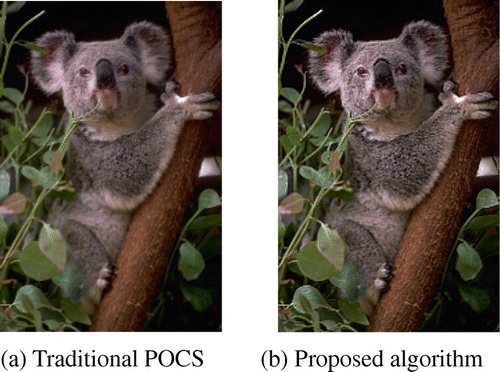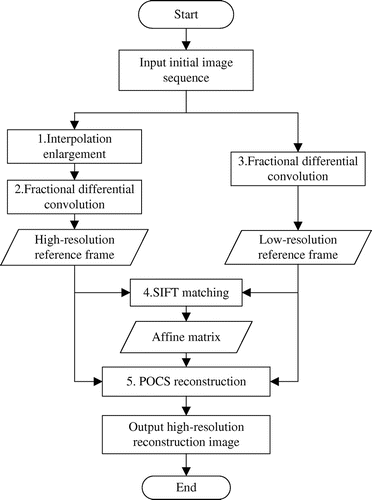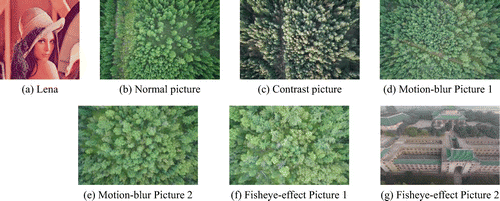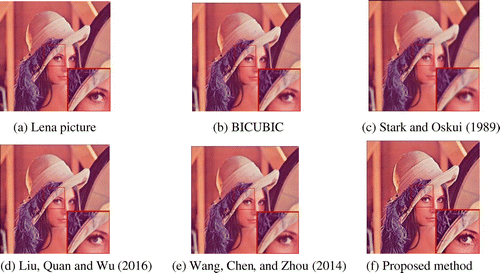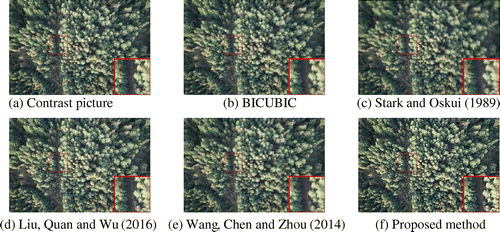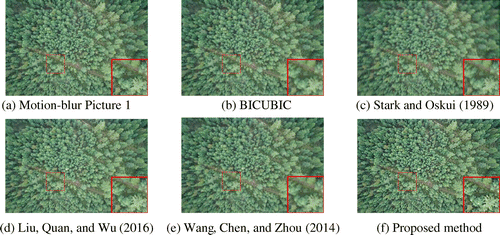Abstract
A super-resolution enhancement algorithm was proposed based on the combination of fractional calculus and Projection onto Convex Sets (POCS) for unmanned aerial vehicles (UAVs) images. The representative problems of UAV images including motion blur, fisheye effect distortion, overexposed, and so on can be improved by the proposed algorithm. The fractional calculus operator is used to enhance the high-resolution and low-resolution reference frames for POCS. The affine transformation parameters between low-resolution images and reference frame are calculated by Scale Invariant Feature Transform (SIFT) for matching. The point spread function of POCS is simulated by a fractional integral filter instead of Gaussian filter for more clarity of texture and detail. The objective indices and subjective effect are compared between the proposed and other methods. The experimental results indicate that the proposed method outperforms other algorithms in most cases, especially in the structure and detail clarity of the reconstructed images.
1. Introduction
In recent years, the use of unmanned aerial vehicles (UAVs) has increased in various fields. The UAVs are gaining outstanding success because of their versatility, flexibility, low-cost and minimized operational risk. Nonetheless, the quality of image from UAVs is sensitive to various internal factors (sensor performance, motion modes, exposure times, etc.) and to complex external conditions (fog, rain, turbulence, bad illumination of the scene, etc.). Thus, the resulting image usually contains deterioration problems, such as dynamic blur, fisheye effect, downsampling. In addition, UAV is with the flight-time limitations. Taking aerial images of a large field will consume a large amount of time, but maximizing the height, which increases the viewing perspective, will reduce the optical detail of image. These problems limit the extensive application of UAVs, especially for obtaining the higher resolution and precision images of target objects. Therefore, a super-resolution enhancement technique is necessary.
Image super-resolution refers to a class of algorithms that synthesize high-resolution images by estimating the values of unknown pixels from original single or multiple low-resolution images. It can provide better visual effect, and have a broad application prospect in remote sensing, military, medical imaging, public security, and other fields (Zhang et al. Citation2015). Image super-resolution methods are mainly divided into three categories: the interpolation-based methods (Bätz et al. Citation2015), the reconstruction-based methods (Bengtsson et al. Citation2012; Xiao et al. Citation2016), and the learning-based methods (Freedman and Fattal Citation2011; Lian and Zhang Citation2012). The interpolation-based methods have simple calculation, but often cannot obtain the ideal super-resolution results. The reconstruction-based methods allow different prior conditions in the reconstruction process to achieve better reconstruction results without cumbersome computational complexity. But it may lose the texture detail information of images because of limited prior knowledge. The learning-based methods rely on external training libraries to restore the ideal high-resolution images. Accordingly, its memory and time consumption are large, and the computational complexity is high. This paper focuses on the reconstruction-based methods combined with Projection onto Convex Sets (POCS) and fractional calculus.
POCS algorithm solves the problem of super-resolution reconstruction based on sets theory. First, the conditions that the solution must meet should be listed according to the prior knowledge, such as positive definite, energy bounded, data reliable, smooth. Then, these conditions are abstracted into several constrained convex sets mathematically. The combination of prior knowledge and solution consequently restricts the solution to the objective convex set. POCS algorithm has been widely researched and applied in the field of image reconstruction since it was proposed in 1989. By combining with wavelet transformation and POCS, Cao et al. (Citation2009) proposed a POCS restoration method based on wavelet transformation and applied it in medical image reconstruction. Zhang, Xu, and Li (Citation2010) proposed the super-resolution reconstruction method based on out-of-core and POCS, and introduced the Scale Invariant Feature Transform (SIFT) matching to improve the effect of POCS algorithm. Gao et al. (Citation2013) proposed an improved fast convergence POCS algorithm, which achieves good results for the reconstruction of standard images. However, the above algorithms fail to get the ideal result in the process of relatively blurred image reconstruction.
As the generalization of traditional integer order calculus in the real number domain, fractional calculus has been studied in the field of mathematics since the concept of calculus was proposed. In recent years, it has been widely introduced in the fields of cybernetics, probability theory, signal processing, and so on (Xu and Tan Citation2006; Yao, Su, and Zhou Citation2004). Pu et al. (Citation2005) proposed a numerical implementation of fractional calculus in the field of signal analysis and initially applied it to two-dimensional image processing. Yang et al. (Citation2008) proposed Tiansi mask operator based on fractional differential, which has achieved good results in the fields of image enhancement and edge detection. Li and Xie (Citation2015) proposed an image denoising algorithm based on small probability model and gradient adaptive fractional calculus, which has good effect in both image denoising and enhancement.
In this paper, the fractional calculus operator is introduced into the POCS super-resolution reconstruction process. By constructing the fractional differential mask, the original low-resolution image and the interpolated image are calculated to obtain more high-frequency information of the image. At the same time, the matching accuracy is improved by SIFT matching in the process of POCS. The fractional integral kernel is used to construct and improve the point spread function in POCS. Experimental data demonstrate that, compared with the traditional algorithm, the proposed algorithm can effectively improve the effect of convex sets reconstruction and enhance both the subjective and objective effect of reconstruction results, especially for blurred images.
2. Basic theory of algorithms
In this paper, the fractional calculus operator is introduced into the POCS reconstruction process. The convex set is defined in a Euclidean space. In a convex set, for every pair of points within the set, every point on the straight line segment that joins the pair of points is also within the set. The following is a brief introduction of the POCS theory and fractional differential in the image processing applications.
2.1. Basic principle of POCS
The main idea of POCS is as follows. The unknown sequence S is restricted in a closed convex set C by every constraint. So if there are n known constraints, there are n corresponding closed convex sets. The reconstructed image is a point within the intersection of all constraint sets. As long as the intersection between the constraints exists, and Ci(i ∊ N) is known as well as the corresponding operators Pi of each set, the sequence S will gradually converge to a point in the set through multiple iterations. In super-resolution reconstruction, we consider that there is a transformational model between high-resolution images and low-resolution images. In this model prior constraints can be such that a high-resolution image by POCS iterative convergence calculation in model space. From the degradation model (Stark and Oskoui Citation1989) of the image, we can know the relationship between the images before and after the degradation in image reconstruction as:(1)
where g(x1, y2) is a degraded image, is the point spread function at point (x0, y0) in the degenerate model, f(x0, y0) is the original high-resolution image, and n(x1, y1) is the possible additive noise.
We assume that ref (x, y) is the result of the interpolation from one of the low-resolution image sequence frames, and m(x, y) is the estimated value of the current high-resolution image through the imaging system. The high-resolution image is obtained according to the degradation model. If the point spread function is normalized to obtain the function h(x, y), then the estimated value of m(x, y) is:(2)
After the estimated value is obtained from the degenerate model of the image, the residual value r between the pixel value g(x, y) of the degraded image and the estimated value m(x, y) is:(3)
The acquisition of the high-resolution image is based on the convex set theory. So, we firstly obtain the residual between the gray value at the observed image pixel and the gray value corrected with the estimated value. The absolute value of the residual is limited to the pre-set boundaries after iteration. Here, it is represented by δ0. The correction process is as follows:(4)
where i = 0, 1, …, L. If f(x, y) is the ideal high-resolution image, according to Equation (Equation1(1) ), the residual should be consistent with the additive noise n(x, y). Accordingly, the residual r should depend on the statistical properties of the noise. Therefore, the POCS algorithm has good robustness to noise. The resulting high-resolution image will converge to a certain set with a certain value under the random noise.
It can be found that to a large extent, the accuracy of the low-resolution image estimation depends on the matching degree relative to the original high-resolution image. The better the matching, the better the accuracy will be. Therefore, in order to improve the effect of super-resolution reconstruction, image registration is also introduced as a constraint to the POCS algorithm. It can obtain the motion parameters between the low-resolution image and the high-resolution image. Thereby the constraint effect of the point spread function is improved.
The resolution improving can be understood as the scale change and fuzzy matching of image. As SIFT feature is invariant to image scaling, it can be used to calculate the motion parameters. SIFT feature is the local feature of the image, which has been widely used in the field of image registration after being improved by Lowe (Citation2004). It not only remains invariance to image translation, scaling, rotation, and illumination changes, but also maintains a certain degree of stability to perspective changes, affine transformation and noise. The traditional POCS algorithms mostly use the Taylor expansion method to obtain the motion parameters, which accuracy is limited. Using the SIFT feature to calculate the motion parameters, the accuracy can be improved effectively. In recent years, many literatures (Zhang, Xu, and Li Citation2010) have taken the SIFT matching as the motion parameter calculation method of POCS, and achieved good results.
2.2. Basic principle of fractional calculus
Fractional calculus is proposed by Leibniz at the same time as the calculus theory (Huang, Xu, and Pu Citation2012). The order of calculus is extended from integer domain to the real domain and even imaginary domain. Out of habit, we still call it fractional calculus. In the application, the fractional calculus has the following several general definitions: the Grümwald–Letnikov (G–L) definition which transforms the fractional transformations into convolution operations, the Riemann–Liouville (R–L) definition which is convenient to calculate and analyze the solution, the Capotu definition which is applicable to fractional differential equations and so on. G–L definition is mainly used herein.
Starting with the classic definition of differential, it extends the order from an integer to a non-integer, which can be expressed as(5)
where the Gamma function is when n is equivalent to the factorial operation
;
denotes the G–L definition; a and t are the upper and lower bounds of the calculated differential values; v is the order of the fractional calculus. The positive and negative of v in
represent the fractional differential and integral, respectively.
When the fractional theory is applied in the image signal, the equal interval of the image signal is at least 1 pixel. Let h = 1, then we can get [(t – a)/h] = [t – a]. Consequently, the definition can be changed to:(6)
The coefficients of each item are taken as the weight. The result of fractional calculus processing can be obtained by convolving the pixel. In practical applications, it is also important to take the errors into account in the different processing directions of the two-dimensional image signal, such as the direction of vertical or parallel to the edge. Handling of different directions can result in significant differences in treatment outcomes.
3. Image super-resolution enhancement algorithm based on fractional calculus and POCS
The traditional POCS reconstruction algorithm cannot achieve good results for the blurred image. The fractional calculus operator which can effectively enhance the high-frequency information of image is introduced into the reconstruction process. The fractional differential window is used to enhance the original interpolated reference image and increase the texture details of the image. Then, the noise or offset introduced in the enhancement is modified by the POCS reconstruction based on the fractional integral kernel function.
3.1. Fractional differential for image enhancement analysis
Considering the directionality of the two-dimensional image, we can establish the isotropic filters of the image in eight directions: 0°, 45°, 90°, 135°, 180°, 225°, 270°, and 315° according to Equation (Equation6(6) ). Respectively, the mask window A with size of 3 × 3 and the mask window B with size of 5 × 5 are obtained as follows:
(7)
where v (− 1 < v < 1) is the order of the fractional mask window. The normalized mask window B is called the Tiansi operator. The simultaneous processing of eight directions can maintain the rotation invariance and isotropy, which is favorable to the calculation of the affine matrix in POCS reconstruction. In practical application, the results of fractional processing can be obtained by selecting the different orders and moving the mask to convolution of the image X as Xv = Av × X or Xv = Bv × X, as shown in Figure .
It can be seen the effects are obviously different in the edge of the leaf texture and water droplets. With the increase of the order of the fractional mask window, the images are significantly enhanced in the details of the texture and clarity, and the details of the edge become obvious as well. At the same time, the larger window can achieve similar effects with smaller order v. It can be found that fractional calculus is largely constrained by the order as a processing method in application.
In order to evaluate the effect for different order of fractional calculus in image processing, the objective evaluation index of information entropy and clarity (Xiao et al. Citation2017) was selected. The image “koala” is processed by fractional operators with different orders. The results are shown in Figure .
Information entropy and clarity are used to score the differential processing results. The size of the mask window is 3 × 3. In Figure , we can find that the information entropy and clarity of image change with the fractional differential order. The evaluation value is approximately linear with the order when the order is less than 0.7. It is no longer linear when the order is greater than 0.7. In Figure , the edge of the image will be over-sharpened in the place where the evaluation target is mutated. It can be considered that the image will not be over-sharpened when the information entropy and clarity of image vary linearly with the order, meanwhile, there will be better effect of image progressing. In the practical algorithm, we use more explicit clarity of linear effect as the index, and make the order as large as possible in ensuring the clarity index in the linear range. From the data in Figure , we can know the ideal order of fractional calculus is 0.7.
3.2. The influence of fractional calculus on the effect of POCS
In the traditional POCS algorithm, the initial high-resolution reference image used in the projection iteration is generally obtained by interpolation. In this paper, we introduce the fractional differential window, and the initial high-resolution reference image is convoluted by fractional mask to enhance the detail texture of the initial high-resolution image. We compare the two results of the traditional POCS algorithm and the proposed algorithm, as shown in Figure .
From the contours of the leaves, the branches of the shrubs, the texture of the bark and the hair of the koala in Figure , we can conclude that the fractional differential operator effectively enhances the texture of the picture, and improves the overall high-frequency information of reconstruction image.
3.3. The proposed algorithm
Based on the analysis of the previous two sections, more high-frequency information in the acquisition of the initial reference frame is obtained in POCS processing. Then the image is subjected to POCS iterations. SIFT operator is used to obtain the matching point of the pixel on the reference frame on the low resolution image. Compared to the image block matching, SIFT cannot only obtain higher accuracy of motion estimation, but also reduce the computational complexity. Using the pixel values at that point on the low-resolution image, the reference frame is corrected by the point spread function processing based on fractional integral. After several iterations, the convergent results of super-resolution reconstruction can be obtained.
According to the above process, we design the following algorithm flow chart as shown in Figure .
The input low-resolution image sequence is denoted as Xi, and the output high-resolution image is denoted as Y. Several steps of the algorithm are described as follows in detail.
Step 1. Take a frame in the low-resolution image sequence. The interpolation of it can be the initial high-resolution reference image Ref. Let k = 0.
Step 2. With the clarity as the reference value, the fractional differential of the low-resolution images Xi and ref are Li and refk, respectively. Bv denotes fractional differential operator.(8)
At the same time, the SIFT operator is used to calculate the transformation matrix Ti between Li and refk.(9)
Step 3. Calculate each point (x, y) in refk by the transformation matrix Ti and obtain the corresponding point (xi, yi) in Ti.
(10)
where the point spread function denotes the fractional integral kernel function centered on point (x, y) with the order of −0.7 and the window of 5 × 5.
Then calculate the corresponding residuals:(11)
Finally, the pixel value of each point (x, y) is corrected in four low-resolution images. The correction threshold δ0 of the residual is set for the empirical value of 0.05.(12)
Step 4. After all points have been corrected, turn to Step 5, if k ≥ 10 or there is no correction process (that is, r always satisfies the inequality − δ0 ≤ r ≤ δ0). Otherwise, let k = k + 1, and turn to Step 3.
Step 5. Output refk+1, which is the reconstructed high-resolution image Y.
4. Experiment results
In order to evaluate the performance of the proposed algorithm, this paper lists other reconstruction algorithms such as BICUBIC interpolation, POCS reconstruction combined with the kern registration (Stark and Oskoui Citation1989), SIFT combined with POCS (Wang, Chen, and Zhou Citation2014), and Laplace operator initialization reference (Liu, Quan, and Wu Citation2016) as contrasts. The results of super-resolution reconstruction are based on subjective visual perception and five objective evaluation indicators (Xiao et al. Citation2016).
The software platform was set as Windows 7 × 64, Visual Studio 2010, and OpenCV 2.4.4; the hardware configuration as Intel Core i3-2120 3.30 GHz; GPU as NVIDIA GeForce GTX 550 Ti. As shown in Figure , the images by which we carry out the super-resolution reconstruction include a standard image Lena and the UAV images taken from the image data-set.
4.1. Objective evaluation indexes
The purpose of image super-resolution is to get a better image signal. In order to measure the performance of the algorithm objectively, we conduct a certain evaluation of the reconstructed image. The evaluation of image quality plays a key role in image processing. The following is a brief introduction to the common objective image evaluation method in the field of image super-resolution.
| (1) | Peak Signal to Noise Ratio (PSNR). PSNR can effectively evaluate the image and meet the subjective feelings of the human eye (Xiao et al. Citation2016). The larger PSNR value means that the target image is closer to the reference image. | ||||
| (2) | Structural Similarity (SSIM). The SSIM between images is an index of the degree of similarity between two images, which is between 0 and 1 (Xiao et al. Citation2016). If the SSIM value is larger, the structure of the original image is more similar to the reconstructed image, and the result of image reconstruction is better. | ||||
| (3) | Edge Preservation Index (EPI). EPI is an indicator of the degree to keep edges before and after image reconstruction. If the EPI value is closer to 1, the effect of image reconstruction is better. | ||||
| (4) | Entropy. The entropy evaluates the image by the probability of the gray value (Xiao et al. Citation2016). The larger entropy means that an image contains more information. | ||||
| (5) | Clarity. Image clarity is also called the image mean gradient, which is obtained by calculating the gradient around the pixel (Xiao et al. Citation2016). It describes the tiny details of the image. If the Clarity value of an image is larger, the image contains richer textures in general. | ||||
4.2. Test low-resolution images
In this paper, we use the simulation method to obtain the low-resolution image sequence. The main method is the original image sub-sampling. The four pixels in the 2 × 2 region are placed in different low-resolution sequences, respectively. In this case, when the image is reconstructed, the reconstructed results can be compared directly to the original image. The generation process of low-resolution image sequence frame is described above. The four low-resolution images produced by the test image Lena are shown in Figure , which are, respectively, based on left-top pixels, left-bottom pixels, right-top pixels, and right-bottom pixels. We can see that four images are similar to each other and have slight different.
4.3. Test results
The reconstruction results of different images are shown in Figures .
Figures show the reconstruction results of several different images under different methods. The edge of the image reconstructed by BICUBIC is relatively obscure; the image reconstructed by Stark and Oskoui (Citation1989) shows a serious pixel shift due to registration error; the edge of the image reconstructed by Liu, Quan, and Wu (Citation2016) has been exposed; the subjective effect of Wang, Chen, and Zhou (Citation2014) is better than that of the previous three algorithms, but the overall contour is blurred; the result of the proposed algorithm has the best visual observation effect.
We carried out experiments on the remaining images in the aerial image library. The objective evaluation results are shown in Table .
Table 1. Objective index values of image reconstruction.
In Table , it can be seen that the evaluation results of the BICUBIC and Stark and Oskoui (Citation1989) are poor when compared with the other three algorithms. The Clarity value of Stark and Oskoui (Citation1989) is too large to result in overexposing for image reconstruction. The Entropy and SSIM value of Liu et al.’s method are sometimes higher than those of the proposed algorithm. This is because the details of the high-frequency part of the image are increased after the Laplace operation. In some pictures these two indicators of Liu, Quan, and Wu (Citation2016) are dominant, but the fractional differential shows the better effect on the middle- and low-frequency information than Laplace operator. Compared with Wang, Chen, and Zhou (Citation2014), we can find that the proposed algorithm is more effective on EPI and Entropy. Considering the existence of the degradation of the original image, the algorithm is not such good in the PSNR index for the fractional operator enhances the high-frequency information. It can be seen from the subjective visual perception that the algorithm results are obviously better than the rest algorithms. With the five objective evaluation indicators, proposed algorithm is the maximum in many cases in the table. It is more effective than other methods.
5. Conclusions
In this paper, a more valuable solution is derived from the initial reference frame in POCS, especially for UAV images. Fractional differential is proposed to convolute with the reference frame to enhance the image details. Then the fractional integral is used as the point spread function to reduce the error caused by fractional differential. The results of this algorithm are compared with some other super-resolution reconstruction methods. The objective index is higher and better in most cases, and the subjective visual effect also shows that the proposed algorithm improves the contrast of the image, while the edge of the image is well preserved. When the initial image degradation occurs, the algorithm is more accommodative.
Funding
This work is supported by the National Key Research and Development Program of China [grant number 2016YFB0502602], the National Natural Science Foundation of China [grant number 61471272], and the Natural Science Foundation of Hubei Province, China [grant number 2016CFB499].
Notes on contributors
Junfeng Lei is an associate professor in the Dept. of Measurement and Instruments in the Electronic Information School, Wuhan University, Wuhan, China. He received his PhD degree from Wuhan University, China, in 2002. He authored or co-authored more than 30 scientific articles in journals, books, and conference proceedings. His work focuses on image and video processing, computer vision, and image and video enhancement.
Shangyue Zhang received her bachelor’s degree from Electronic Information School, Wuhan University, China, in 2017. She is now a graduate student in Information and Communication Engineering at the School of Electronic Information, Wuhan University. Her research is in the fields of image and video enhancement, and computer vision.
Li Luo received her bachelor’s degree from Electronic Information School, Wuhan University, China, in 2017. She is now a graduate student in Information and Communication Engineering at the School of Electronic Information, Wuhan University. Her research is in the fields of image and video enhancement, and computer vision.
Jinsheng Xiao is an IEEE member and an associate professor in Information and Communication Engineering at the Electronic Information School, Wuhan University, China. He received his bachelor’s degree in computational mathematics at Wuhan University, China, in 1996 and PhD degree in mathematics from Wuhan University, China, in 2001. He has authored or co-authored more than 50 scientific articles in journals, books, and conference proceedings. His work focuses on image and video processing, computer vision, and image and video enhancement. He is the corresponding author of this paper.
He Wang received his master’s degree from Electronic Information School, Wuhan University, China, in 2017. He is engaged in research in the fields of image and video enhancement, and computer vision. He works in The Third Research Institute of Ministry of Public Security in Shanghai.
Acknowledgments
We would like to thank Kai Yan, Xihan Mu, Gaiyan Ruan, and Yingji Zhou, School of Geography, Beijing Normal University, for part of the UAV images used in this study are chosen from their article “Dataset of UAV remote sensing images in forest district of the Genhe River Basin in 2013”.
References
- Bätz, M., A. Eichenseer, J. Seiler, M. Jonscher, and A. Kaup. 2015. “Hybrid Super-resolution Combining Example-Based Single-Image and Interpolation-based Multi-image Reconstruction Approaches.” Paper presented at the Proceedings of the IEEE International Conference on Image Processing, Quebec City, Canada, September 27–30, 58–62.
- Bengtsson, T., Y. H. Gu, M. Viberg, and K. Lindström. 2012. “Regularized Optimization for Joint Super-Resolution and High Dynamic Range Image Reconstruction in a Perceptually Uniform Domain.” Paper presented at the Proceedings of the IEEE International Conference on Acoustics, Speech and Signal Processing, Kyoto, Japan, March 25–30, 1097–1100.
- Cao, Y., X. Liu, W. Wang, and Z. Xing. 2009. “Super-resolution Image Reconstruction Algorithm Based on Projection onto Convex Sets and Wavelet Fusion.” Journal of Biomedical Engineering 26 (5): 947–952.
- Freedman, G., and R. Fattal. 2011. “Image and Video Upscaling from Local Self-examples.” ACM Transactions on Graphics 30 (2): 12.
- Gao, J., A. Stanton, M. Naghizadeh, M. D. Sacchi, and X. Chen. 2013. “Convergence Improvement and Noise Attenuation Considerations for beyond Alias Projection onto Convex Sets Reconstruction.” Geophysical Prospecting 61 (S1): 138–151.10.1111/gpr.2013.61.issue-s1
- Huang, G., L. Xu, and Y. Pu. 2012. “Summary of Research on Image Processing Using Fractional Calculus.” Application Research of Computers 29 (2): 414–420.
- Li, B., and W. Xie. 2015. “Adaptive Fractional Differential Approach and its Application to Medical Image Enhancement.” Computers & Electrical Engineering 45: 324–335.10.1016/j.compeleceng.2015.02.013
- Lian, Q., and W. Zhang. 2012. “Image Super-resolution Algorithms Based on Sparse Representation of Classified Image Patches.” Acta Electronic a Sinica 40 (5): 920–925.
- Liu, Y., W. Quan, and S. Wu. 2016. “Regularized Super-resolution Image Reconstruction Based on Edge Enhancement.” Journal of Xi’an University of Posts and Telecommunications 21 (6): 14–19.
- Lowe, D. G. 2004. “Distinctive Image Features from Scale-invariant Keypoints.” International Journal of Computer Vision 60 (2): 91–110.10.1023/B:VISI.0000029664.99615.94
- Pu, Y., Y. Xiao, L. Ke, Z. Chen, and J. Zhou. 2005. “Five Numerical Algorithms of Fractional Calculus Applied in Modern Signal Analyzing and Processing.” Journal of Sichuan University 37 (5): 118–124.
- Stark, H., and P. Oskoui. 1989. “High-resolution Image Recovery from Image-plane Arrays, Using Convex Projections.” Journal of the Optical Society of America A 6 (11): 1715–1726.10.1364/JOSAA.6.001715
- Wang, F., G. Chen, and W. Zhou. 2014. “Multi-frame Image Super-Resolution Reconstruction Based on SIFT.” Computer Technology and Development 24 (11): 39–42.
- Xiao, J., G. Pang, Y. Zhang, Y. Kuang, Y. Yan, and Y. Wang. 2016. “Adaptive Shock Filter for Image Super-resolution and Enhancement.” Journal of Visual Communication and Image Representation 40 (Part A): 168–177.10.1016/j.jvcir.2016.06.015
- Xiao, J., T. Liu, Y. Zhang, B. Zou, J. Lei, and Q. Li. 2016. “Multi-focus Image Fusion Based on Depth Extraction with Inhomogeneous Diffusion Equation.” Signal Processing 125: 171–186.10.1016/j.sigpro.2016.01.014
- Xiao, J., E. Liu, L. Zhao, Y. Wang, and W. Jiang. 2017. “Detail Enhancement of Image Super-resolution Based on Detail Synthesis.” Signal Processing: Image Communication 50: 21–33.
- Xu, M., and W. Tan. 2006. “Intermediate Processes and Critical Phenomena: Theory, Method and Progress of Fractional Operators and Their Applications to Modern Mechanics.” Science in China (Series G): Physics, Mechanics & Astronomy 49 (3): 257–272.
- Yang, Z., J. Zhou, X. Yan, and M. Huang. 2008. “Image Enhancement Based on Fractional Differentials.” Journal of Computer − Aided Design & Computer Graphics 20 (3): 343–348.
- Yao, K., W. Su, and S. Zhou. 2004. “On the Fractional Calculus Functions of a Type of Weierstrass Function.” Chinese Annals of Mathematics, Series a 6 (6): 711–716.
- Zhang, Y., K. Xu, and Y. Li. 2010. “Remote Sensing Image Super-resolution Based on POCS and out-of-Core.” Journal of Tsinghua University (Science and Technology) 50 (10): 1743–1746.
- Zhang, K., D. Tao, X. Gao, X. Li, and Z. Xiong. 2015. “Learning Multiple Linear Mappings for Efficient Single Image Super-resolution.” IEEE Transactions on Image Processing 24 (3): 846–861.10.1109/TIP.2015.2389629



